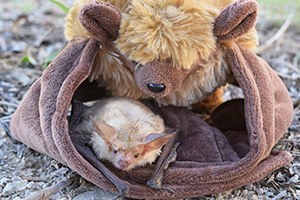Animal Fact Sheet: Bark Scorpion |
|
Identifying Features The bark scorpions (Centriroides exilicauda) body has two parts, a cephalothorax and abdomen. The tail is actually a part of the abdomen. It has five segments each longer than the last; at the tip is the stinger (not considered a segment). They have 8 jointed legs and a pair of pedipalps that are used for grasping prey and sensing. |
 |
Adaptations Scorpions have "hairs" on their legs and other body parts that are sensitive to vibrations in the air. To avoid the extreme heat of the daytime they will shelter in the shade and come out at night to hunt for food. In the winter months they will hibernate, often congregating in large groups. |
Habitat The bark scorpion can be found in many places due to its ability to climb. It can be found not only under rocks or in rock crevices, but also in trees or high on rock walls. They also can be found inside of peoples dwellings trapped in sinks or bathtubs, climbing walls, or in a dark closet. |
Range The bark scorpion occurs from southern California through southern Arizona into western New Mexico; and in adjacent Mexico (Baja California, Sonora, and Chihuahua). |
Wild Status They are common and widespread throughout their range. |
Diet Scorpions are predators. They consume all types of insects, spiders, centipedes, and even other scorpions. |
Predators Scorpions are preyed upon by large centipedes, tarantulas, lizards, birds (especially owls), and mammals such as bats, shrews, and grasshopper mice. |
Home They prefer cool and moist areas and can be found in crevices, under pieces of bark, under rocks, under bricks and in houses. |
Life Span Scorpions live at least 2-6 years although many live much longer, especially in the wild. |
Size They are 2-3 inches long. |
Extra Fun-facts
|
 ©Copyright 2008, Arizona-Sonora Desert Museum
©Copyright 2008, Arizona-Sonora Desert Museum










